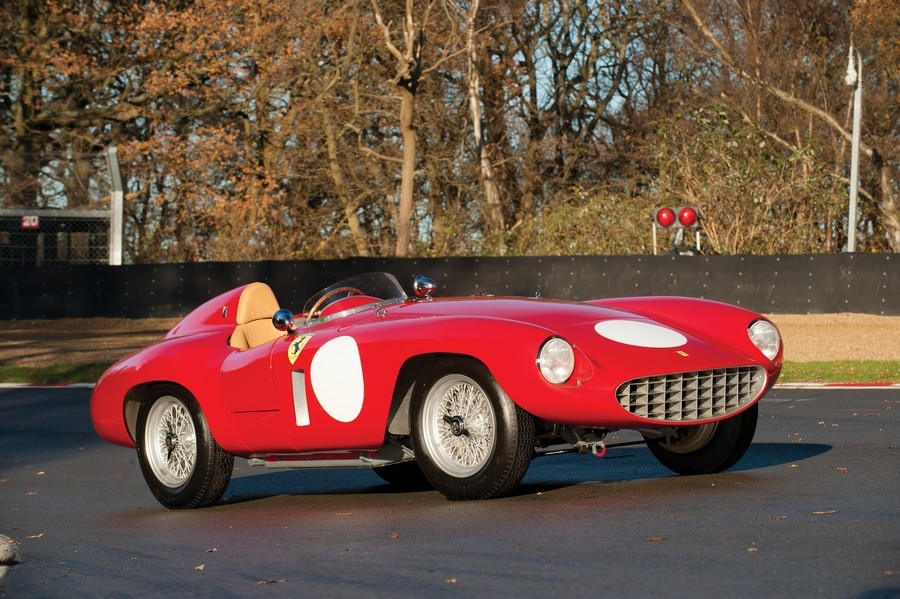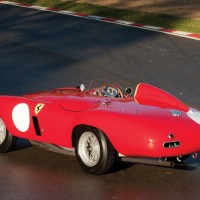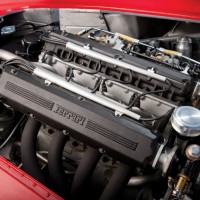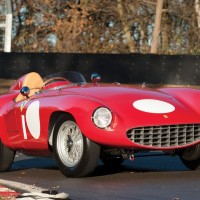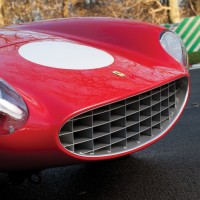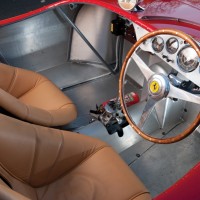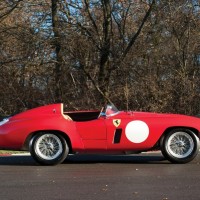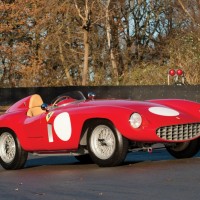SCM Analysis
Detailing
| Vehicle: | 1955 Ferrari 750 Monza Spyder |
| Number Produced: | 31 |
| Original List Price: | N/A |
| Chassis Number Location: | Center of front cross member |
| Engine Number Location: | Crankcase under exhaust port |
| Club Info: | Ferrari Owners Club |
| Website: | http://www.ferrariownersclub.com |
This car, Lot 27, sold for $2,623,832, including buyer’s premium, at RM Auctions’ Paris sale on February 5, 2014.
I think the best way to start this profile is with an overview to show how the Monza and its brethren fit into the pantheon of Ferrari racers over the years.
From the beginning until at least the mid-1960s, there are four more or less distinct generations of Ferrari racers. The early cars used a simple ladder-frame chassis with transverse leaf springs, conventional transmissions, live axles, and, for the most part, crazy horsepower. They have been described as trucks with huge engines. Although they were fast, they were also difficult — and not very comfortable — to drive.
The classic examples of this generation were the 340 and 375 MMs of 1953–55. The competition, particularly Jaguar, Aston Martin, and Maserati, were producing much more sophisticated, supple and effective alternatives by then, and Ferrari found it necessary to up their game.
Enter the Mondial and Monza
The resulting second generation has sometimes been called Ferrari’s experimental period, and it includes the Mondial and Monza. Ferrari largely abandoned the traditional V12 engine in favor of the much simpler, lighter and more torque-oriented straight 4-cylinder engine. Ferrari engineers adopted a transaxle layout with De Dion IRS to achieve better balance. Ferrari actually started thinking about building slippery bodywork (thus moving away from Enzo’s famous dictum: “Aerodynamics are for people who can’t build engines”).
These cars were very successful for a few years and led to the third generation, where the V12 with conventional transmission/live axle layout was reintroduced with much more advanced chassis design, eventually producing the iconic Testa Rossas, SWBs, and the GTO (the factory team racing cars retained the IRS transaxle layout).
As an interesting aside, although everything evolved, it has been pointed out that except for moving from transverse leaf springs to coils and from lever shocks to tubular ones, the front suspension remained essentially unchanged through this entire period: forged A-arms with absolutely no adjustability.
In the early 1960s, Ferrari began the move to mid-engined racers, and these can be thought of as the fourth generation.
The start of a colossus
The Mondials and Monzas, then, were Ferrari’s first step toward what we now consider to be the greatest of the front-engined racers. Handling, aerodynamics, and driver comfort began to share the platform with sheer horsepower. Weight became more important, and the feeling of balance and lightness — particularly in the way the cars responded to steering and throttle in the corners — started to match what the competition was offering.
To Ferrari enthusiasts fixated on the idea that all real Ferraris had V12 engines, the straight 4-cylinder engines (and a few straight sixes) seem to be an anachronism, but they proved to be very effective at winning races in their day. The original idea came along in Formula 2 racing. Although the V12 Ferraris did very well, it was apparent that the lighter, 4-cylinder cars with superior torque from English competitor HWM had an advantage on tight circuits. So Ferrari directed chief engineer Lampredi to come up with a matching design. This proved to be a very successful decision, with Ferrari winning the GP championship in 1952 and 1953 using the 4-cylinder engine.
When designing the more or less clean-sheet-of-paper “small” Mondial and Monza racers (remember the 375s were 4.5-liter cars), using the 4-cylinder engine was a logical approach, and in 1954 both were introduced.
Torque on the twisties
The 750 Monza was used both as a team racer and as a customer car, and with 31 built (plus four V12 250 Monzas), is the highest-production sports racing Ferrari ever. Its glory years were 1955 and 1956, although they remained competitive for several years after that. They were particularly strong on the tight, twisty venues, and not just because of the abundant torque. Discussing the big 4-cylinder engines in comparison with the V12 variants, Juan Fangio observed that he preferred them because once the brakes went away, as they invariably did, at least there was engine braking available with the 4-cylinder cars.
Once a thrashed racer
Collectors and enthusiasts for the past 30 years or more have thought of Ferrari race cars as treasured possessions, exciting, drivable artifacts of a glorious — and in many ways innocent — time of brave drivers racing for glory more than money. More recently, these cars became symbols of wealth and accomplishment.
All this said, we frequently lose track of the fact that these cars were once just disposable weapons. The collector’s ideal of a car with completely original everything — pristine in its originality — pretty much requires a car that never really ever did anything in its day.
The real warriors were bashed, crashed, bent, blown up, and jury-rigged back together to make the next race — over and over until they were more or less thrown away. There are exceptions, of course, but it is generally true that the more history a car has, the more compromised it is — or was. That is certainly true of our subject car. As an American racer, its competition résumé is hard to match, with famous drivers (Piero Taruffi, Phil Hill, Paul O’Shea and Carroll Shelby) and excellent results over a number of years. The down side is that when they were done, there was virtually nothing left of the car.
Stripped and abandoned
Having suffered the ignominy of having its engine and transaxle lost and replaced with a V8 engine, transmission and live axle, this car got to sit outside of a Texas barn for 30 years before being found again. It then went to Australia, where it got a new body (the remains of the old one stayed with it, which is good) and a thorough mechanical restoration.
Its engine is composed of an original crankcase (welded up where a rod went through it) and otherwise all new components apparently created in New Zealand. I have no idea where the transaxle came from, although it is possible the original was found and reunited.
The bottom line is that in a Classiche-worshipping, matching-numbers- and originality-obsessed world, this was about as compromised a 750 Monza as you are likely to find, and the sales price in Paris reflected just that. I would expect a good 750 Monza to bring around $3.5 million in today’s market, with a great one well above that.
This Ferrari is a real car, and I believe it is an excellent driver and racer. It just didn’t have the credentials that make the big-money bidders raise their paddles.
As such, candidly, it sold cheaply. It is still a great Ferrari with great history, and its investment potential mirrors the expensive examples. In 2004, a good Monza was worth $1 million at auction, and this one would have probably made $750k–$800k. Both cars have gone up by a factor of 3.5, so who’s to argue?
I’m told that enough of the original body remains that it could be restored as original if somebody wanted to make the investment in time and money, and Ferrari could probably be persuaded to supply a Classiche-acceptable, factory-numbered replacement engine. So it is not implausible to remove the asterisks and make this into a top-level car (with a number of very desirable spares left to sell to help finance the project). As such, the buyer could have it either way. I would say that this car was very well bought. ♦
(Introductory description courtesy of RM Auctions.)
